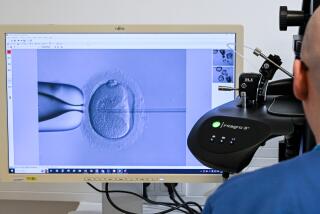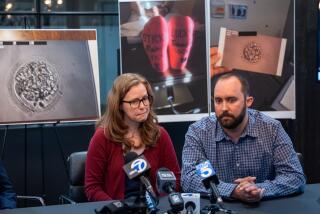Octuplet doctor’s record dubious
The Beverly Hills doctor whose fertility treatment led to the birth of Nadya Suleman’s octuplets -- and her six previous children -- has one of the worst success rates of any fertility clinic in the country, according to federal records reviewed by The Times.
In fact, Suleman’s children represent a sizable portion of the pregnancy rate at his clinic over the last several years -- and taxpayers are already footing part of the bill.
Suleman receives at least $490 a month in food stamps, and three of her first six children are disabled and receiving federal benefits. Moreover, Kaiser Permanente’s Bellflower Medical Center has asked California’s health plan for the poor to cover the enormous cost of medical care for the eight premature infants in its care, according to multiple sources familiar with the case.
The disclosures came as the identity of the doctor who provided Suleman, a 33-year-old single mother, with the in vitro fertilizations became public Monday. In an interview on NBC, she identified the clinic as West Coast IVF Clinic, which is run by Dr. Michael M. Kamrava.
Kamrava, 57, has presented himself in interviews and on his website as a medical pioneer who discovered a breakthrough in in vitro fertilization procedures.
But according to federal records reviewed by The Times, of the 61 procedures he conducted in 2006 -- the most recent data available -- only five resulted in pregnancies and only two of those resulted in births. One of those births was Suleman’s twins.
The pregnancy rate achieved by his clinic was so low that it probably spurred a professional association to offer him help in improving his record.
“These are the worst numbers I’ve ever seen. This is absurdly low,” said Dr. Mark Surrey, another fertility specialist in Beverly Hills.
But in Suleman, Kamrava found a patient who got pregnant and gave birth every time.
For seven years, Suleman attempted to get pregnant through artificial insemination and fertility drugs. When she finally tried in vitro fertilization at Kamrava’s clinic, it worked the first time -- and each time after that.
Among IVF specialists in Southern California, Kamrava is known for promoting techniques to improve success rates.
He has been a proponent of placing newly created embryos in a capsule and cultivating them inside the vagina for a few days before transferring them to the uterus in hopes of achieving a pregnancy. More recently, he has promoted a little-used technique employing a camera to help place embryos in the lining of the uterus. In 2006, he and Suleman appeared together in a KTLA-TV Channel 5 news segment about how the technique could boost the chances of success.
And on his website, he touts his “breakthrough technology that has revolutionized IVF.”
In fact, Kamrava’s clinic has a much lower rate of pregnancies and births than the vast majority of fertility clinics across the country.
His history of poor results comes despite the fact that Kamrava places more embryos per procedure than all but 10 of the nation’s 426 fertility clinics for patients younger than 35. In 2006, he averaged 3.5 embryos per in vitro fertilization treatment, compared with the national average of 2.3.
Other fertility specialists said that placing high numbers of embryos is a common way that poorly performing clinics try to boost their pregnancy rates. But that increases the risk of multiple births, which pose a danger to the women and their babies.
Dr. Philip McNamee, a fertility specialist in Honolulu, said Kamrava may have believed he had little to worry about when he transferred six embryos to Suleman last year since his success rates were so low and her embryos had been frozen and thawed. Frozen embryos lead to pregnancy less frequently than fresh ones.
“That is one logical explanation of why he thought in his mind he could do it,” McNamee said.
Still, he and other doctors strongly condemned the decision, especially because Suleman had a history of successful pregnancies.
Not only did all six embryos take, two of them led to twins, Suleman told NBC.
In the interview, Suleman defended her doctor. She called her treatment “very appropriate,” particularly because of her history of miscarriages and scarred fallopian tubes.
“The most I would have ever anticipated would have been twins,” Suleman said. “It wasn’t twins times four.”
Kamrava declined to comment to reporters who swarmed his office Monday.
This is not the first time he has faced controversy. At least two of his former employees have sued him, including Shirin Afshar, an office administrator who alleged that Kamrava engaged in systematic insurance and tax fraud. She also said he routinely asked her to participate in medical procedures even though she was not licensed to do so.
The suit said Kamrava required patients to pay in cash, which was given to Kamrava’s wife, who “never entered the payment into the computer and never deposited the payment in the bank” so that Kamrava could avoid paying income tax on the money. The clinic kept two sets of books, one for insurance payments and one for cash payments, the lawsuit alleged.
Afshar also charged that Kamrava’s office systematically defrauded insurance companies by double billing for procedures and by billing companies for unnecessary medication that Kamrava kept and then resold to other patients. The suit appeared to have settled in 1999, shortly before it went to trial.
In another case, Shantal Rajah, an embryologist from England, was awarded more than $300,000 in back pay, attorney fees and damages after working for Kamrava for less than a month. Court papers show that Rajah and Kamrava did not get along and at one point got into a fight over the proper heating of embryos.
Suleman’s case has evoked fascination and fury among the public and the medical community, with many wondering how she will care for 14 children.
Suleman, who lives with her mother in a three-bedroom home, acknowledged in the NBC interview that she was struggling financially to support her six children before the birth of her octuplets. But she said she knows she will be able to pay their bills, especially after she earns her master’s degree in counseling from Cal State Fullerton.
Suleman’s publicist, Michael Furtney, confirmed the information about the food stamps and federal supplemental security income after two sources informed The Times of the benefits. Three sources told The Times that Kaiser has requested Medi-Cal reimbursement for care of the octuplets, which is estimated to run into hundreds of thousands of dollars. Furtney declined to confirm the Medi-Cal coverage and referred the question to Kaiser, which also declined to comment.
She had denied that she was on welfare -- a comment her publicist later clarified.
“In Nadya’s view, the money that she gets from the food stamp program . . . and the resources disabilities payments she gets for her three children are not welfare,” Furtney said. “They are part of programs designed to help people with need, and she does not see that as welfare.”
--
--
Times staff writers Andrew Blankstein, Cara Mia DiMassa, Victoria Kim, Joanna Lin and Garrett Therolf, and researcher Maloy Moore contributed to this story.
More to Read
Sign up for Essential California
The most important California stories and recommendations in your inbox every morning.
You may occasionally receive promotional content from the Los Angeles Times.












